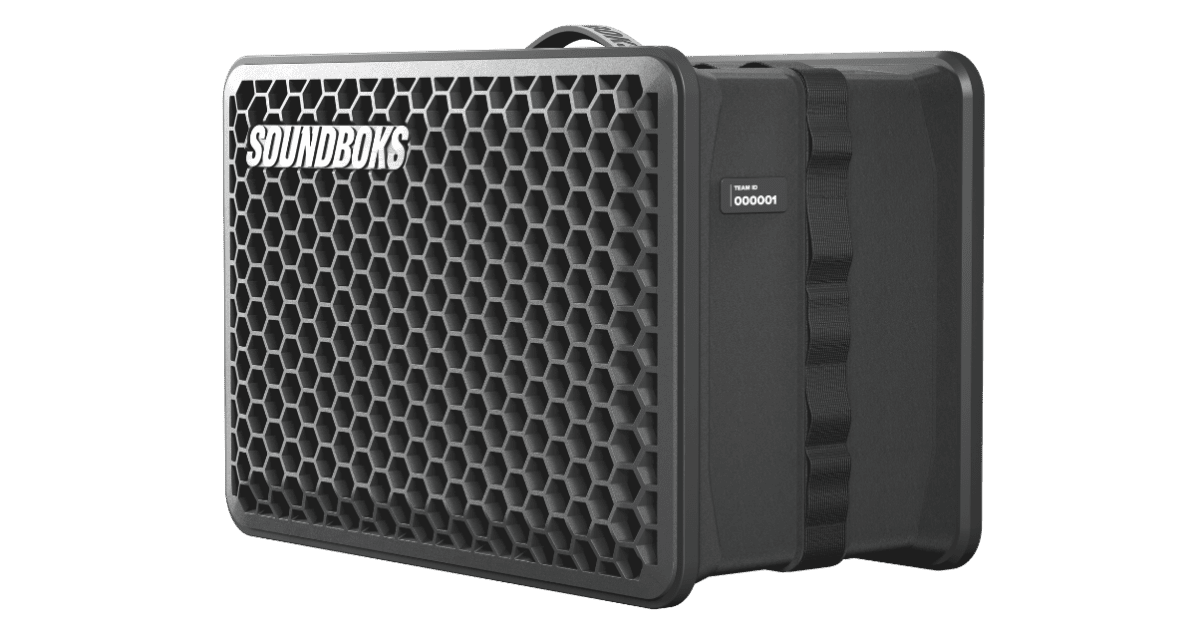The Lowdown
The Soundboks Go is a “performance Bluetooth speaker”, designed – as all of these speakers are – first and foremost for non-DJs. But as it has a bass-heavy sound, goes really loud, has a no latency line-in, and the ability to link low latency to other Soundboks speakers via its SKAA tech, it is actually also a good party DJ speaker – especially if you find the original Soundboks 3 just too big. It’s a bit pricey though, especially when you factor in the optional carrying strap.
Don’t have our latest DJ gear guide? Click here to grab your free copy
Video Review
First Impressions / Setting up
It is about half the size of the near-legendary Soundboks 3 speaker (here’s our review of that one). The Soundboks 3 looks like a PA speaker, whereas this looks like Hummer’s take on a Bluetooth speaker!
It’s chunky but modern, being made of tough plastic with a milk crate-style grille, rubberised rings around it, and folded fabric attached to its sides and top that can be used to hook on the optional extra carrying strap.
If you don’t use the carrying strap, it has a nice, thick rubber handle, which is just about OK to lug its 9kg of weight around.
It has a battery pack, the same one as on the Soundboks 3, and comes with a charger that can be attached at the same time for mains power, although you’re advised to only run it louder than half volume if on battery, for some reason. The battery lasts 10 hours at full pelt, much longer at lower volumes, which is great.
It has a single 10-inch woofer and a one-inch dome tweeter. Each driver has its own 72-watt Class D amplifier.
To get going, you hold down the on/off/volume knob until the lights come on, pair with a Bluetooth device, and hit play. But the nuances are what count, so let’s look at them, and talk about its sound quality too.
Read this next: The 4 Types Of Loudspeaker Every DJ Needs To Know About
In Use
We hooked up using Bluetooth and a phone, and also a DJ controller.
First impressions are that it is very bassy, even outdoors. It actually has three modes, an indoors mode, a “power” mode for ultimate volume, and a boosted bass mode. Notwithstanding all of that, you’ll probably want to customise the EQ, which is easy to do, and you can even save your profile.
All of this, of course, is done in the free accompanying app, where you can also pair it with other Soundboks speakers, using the very low latency SKAA system. And while it lacks the pro inputs and outputs of the Soundboks 3 (remember, it is not being marketed as a DJ speaker), crucially it does have a line-in 1/8″ minijack, which is latency free – we tested it.
Therefore it is not only possible to DJ on this speaker, but also to DJ on at the very least a pair of them (that’s what we tested – two, linking it to a Soundboks 3). Impressive.
As if to underline its positioning right on the edge of consumer Bluetooth speakers and pro speakers, it also has a stand mounting hole, which would position the speaker horizontally were you to use it. I suspect most people will happily just plonk it on the ground, a table or a wall though. It is worth getting the positioning right, as we found out, because you want to try to tame its naturally bass-heavy tendencies.
Conclusion
The Soundboks Go is marketed as a “performance Bluetooth speaker”, designed – as most such speakers are – first and foremost for non-DJs. But as it has a bass-heavy sound, goes really loud, has a no latency line-in, and the ability to link low latency to other Soundboks speakers via its SKAA tech, it is actually also a good party DJ speaker.
Learn to DJ with Digital DJ Tips: The Complete DJ Course
If you loved the idea and aesthetic of the Soundboks 3 but just wanted a smaller one, this is for you – but if not, definitely seriously consider the original Soundboks 3, which does sound better and obviously is also louder, plus it has more “pro” features that you may be grateful for down the line.
If you want to go more “pro”, you may want to look at speakers like the HK Audio Move (here’s our review), the Bose L1 Pro8, the Mackie Thump Go, and the JBL Eon One – or if style isn’t your thing (but you like flashing lights!) the ugly but very capable consumer-focused Sony MHC-V73D looks like a great party speaker (we haven’t tested its all-important latency for DJing though, so buyer beware on that one). Many of these cost less than the Soundboks Go – which it has to be said is pretty expensive, not least when compared to the Soundboks 3.
Overall, the Soundboks Go is a good addition to the Soundboks range, which we suspect will appeal to enough people for it to be a success.
Want help choosing gear? Grab your free PDF: The Digital DJ Gear Buyer’s Guide


